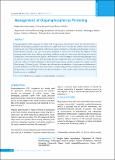Please use this identifier to cite or link to this item:
https://hdl.handle.net/20.500.14356/1679| Title: | Management of Organophosphorus Poisoning |
| Authors: | Bajracharya, Sangha Ratna Prasad, Pratap Narayan Ghimire, Rakesh |
| Citation: | BajracharyaS. R., PrasadP. N., & GhimireR. (2017). Management of Organophosphorus Poisoning. Journal of Nepal Health Research Council, 14(3). https://doi.org/10.33314/jnhrc.v14i3.868 |
| Issue Date: | 2016 |
| Publisher: | Nepal Health Research Council |
| Article Type: | Review Article |
| Keywords: | Cholinesterase management Organophosphorus poisoning |
| Series/Report no.: | Sep-Dec, 2016;868 |
| Abstract: | Abstract Organophosphorus (OP) compounds are widely used for agriculture, domestic pest-control and chemical warfare. Pesticide self-poisoning accounts for one-sixth to one-eighth of the world’s suicides and a third of suicide deaths in rural Asia each year. OP pesticides inhibit cholinesterase enzymes leading to overstimulation of cholinergic receptors. Clinical features depend on the types of receptors stimulated at various sites of the body. The diagnosis of OP poisoning is made on the basis of history of poisoning, smell of pesticides, the characteristic clinical signs and reduced cholinesterase activity. Measurement of plasma cholinesterase is useful for diagnosis of OP poisoning although it may not directly correlate with severity of the poisoning. Atropine remains the main stay of treatment of OP poisoning with clear evidence of benefit if administered effectively. Atropine therapy should be monitored to maintain systolic blood pressure > 80 mmHg, pulse > 80 beats/min and clear chest on auscultation. Oximes reactivate cholinesterase enzymes and help to overcome even the nicotinic effects of OP poisoning. However, evidence for its effectiveness after self-poisoning is weak. Although several newer adjuvant therapies are tried to achieve better outcome, their potential benefits are not yet established. Keywords: Cholinesterase management; organophosphorus poisoning. |
| Description: | Review Article |
| URI: | http://103.69.126.140:8080/handle/20.500.14356/1679 |
| ISSN: | Print ISSN: 1727-5482; Online ISSN: 1999-6217 |
| Appears in Collections: | Vol. 14 No. 3 Issue 34 Sep-Dec 2016 |
Files in This Item:
| File | Description | Size | Format | |
|---|---|---|---|---|
| 868-Article Text-1633-2-10-20170528.pdf | Fulltext Download | 291.73 kB | Adobe PDF |  View/Open |
Items in DSpace are protected by copyright, with all rights reserved, unless otherwise indicated.
